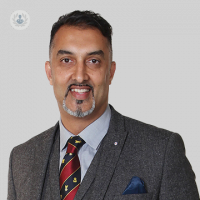Common sports injuries: treatment and prevention
Written in association with:Sports injuries are very common, and often require treatment to heal properly. In his latest article, renowned orthopaedic surgeon Mr Ansar Mahmood answers the most frequently asked questions regarding these injuries.

What are the most common sports injuries?
The most common sports injuries affect the knee, but it is somewhat dependent on the sport that you do. If you are a boxer, knee injuries can be relatively uncommon. Instead, it is the hand, wrist or shoulder that is most likely to be injured.
Our clinic has a blog on different sports injuries written by our sports medicine specialists. Each blog is dedicated to a different sport, including running, cycling and throwing sports. All of these sports have different injuries that are more common to each.
It is essential that you see a specialist who is an expert in the specific injury you have, in order to receive the best possible care and the best chance at a full recovery. The rehabilitation should be designed to protect function in those particular sports. Our clinic ensures that you get the appropriate rehabilitation following a sports injury.
What can I do to prevent sports injuries?
Prevention is very important in sports injuries. Over the last 30 years of sports rehab, many game-changing studies have shown that you can modify the risk of sports injuries. One landmark study looked at knee injuries in women who play sports that involve jumping, such as basketball. Women were four times more likely to suffer from knee injuries, but if they slightly changed the way they jumped, the likelihood of injury was lowered significantly.

This shows the importance of education in preventing injuries. It is also imperative that athletes maintain their strength and condition their bodies properly. This involves stretching correctly, and gradually increasing weight over time. These tips can also greatly lower the risk of injury.
How are sports injuries treated?
Sports injuries are treated using the exact same process as any other injury process. Once the injury has been diagnosed, then the treatment and rehabilitation plan can be devised tailored to the needs of the athlete. For different sports, this can mean different things. The goal is to get the athletes back to the function that they had prior to the injury. This involves a combination of simple interventions like exercise, or non-invasive interventions like shockwave therapy, low-intensity pulsed ultrasound, laser light therapy, or injections.
Which sports injuries require surgery? What would this surgery entail?
The type of injuries that require surgical intervention are the injuries which leave the patient with instability or laxity. A simple way of imagining this is looking at the tendon, which is attached to a bone at one end and muscle at the other. It works like a pulley system. If the tendon become injured, this system can stop working well, and lead to a loss of strength or laxity.

If you have a complete tear and this leaves you with any instability, you may need surgery to repair or reconstruct this torn tissue or ligament. Common parts of the body affected by these injuries include the ligaments in the knee such as the anterior cruciate ligament (ACL), or the ligaments around the shoulder, known as the rotator cuff.
Mr Ansar Mahmood is a leading orthopaedic surgeon based in Stafford. If you would like to book a consultation with Mr Mahmood you can do so today via his Top Doctors profile.


